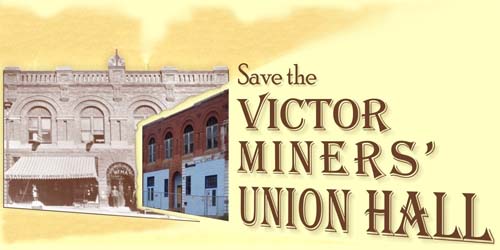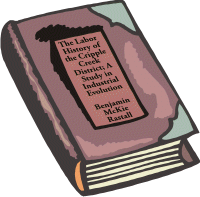 |
Victor
|
The Labor History of the Cripple Creek District;
A Study in Industrial Evolution
by Benjamin McKie Rastall

pages 162-163
SIGNIFICANCE OF THE LABOR HISTORY
The final Cripple Creek strike is to be partially explained in terms of its approach to frontier character. The psychologist will wish to trace the effect of the great altitude as it works to make men more irritable and easily excited, and to make easy, sudden and extreme bursts of passion. But the fuller explanation of the violence, the bitterness, and the disruption of the community must be sought in the geographical and political isolation of the district, and the centering of its whole industry in mining. The miners unions included so large a preponderance of the district workmen, and had such complete sway of the local trades council, as to represent practically the laboring class. When mining ceased business ceased. Who struck a blow at mining struck a blow at the entire business interests of the district. One line of cleavage divided the district, and he who did not stand on one side found it hard not to stand on the other. Hence the solid front of the Mine Owners' Association, and Citizens' Alliance. United labor on one side, and united business interests on the other. This general economic cleavage continued naturally into the political arena, each of the two parties rallying an interest to its banner. The political struggle was resultingly heated and severe, and much partisan bias was to be expected of the successful candidates. A people was split into two great classes economically and politically for the working out of an industrial crisis.
The Cripple Creek strike stands in one way for partial frontier conditions, in another it may represent the completion of a modern industrial development ahead of its time. Recent movements in the industrial field, the intense labor union activity, the efforts for more inclusive and far reaching organization, and the growth of the sympathetic strike, on one side; the formation of various types of employers associations and citizens alliances, with state and national affiliation, on the other, all point in the same direction — toward the widening of the areas of conflict — a more general and complete engagement of social forces when an industrial dispute is to be settled. Any influence that precipitates the generalizing of the movements can easily find its way into the political field.
In the Cripple Creek District this movement has completed its development, and the final issue has been fought to a finish. Other communities and sections approach the same conditions. There do not lack of indications of a general current sweeping the entire nation to such a final issue. History will tend to repeat itself when the culminations come. It may well be that in the throes of the Cripple Creek conflict lie auguries of the future, lessons for both parties to the strife, and for the "powers that be" in state, in county, and in town.
The strike may be summarized thus: The unions sowed class consciousness, and it sprang up and destroyed them. Control passed from one class to another, and in the Cripple Creek District class rule is supreme.
NEXT: Bibliography